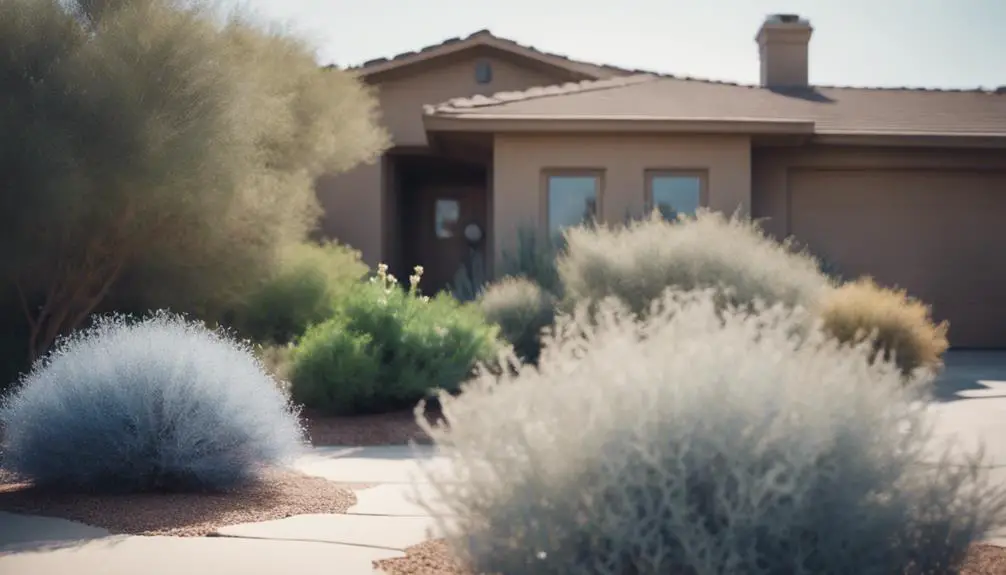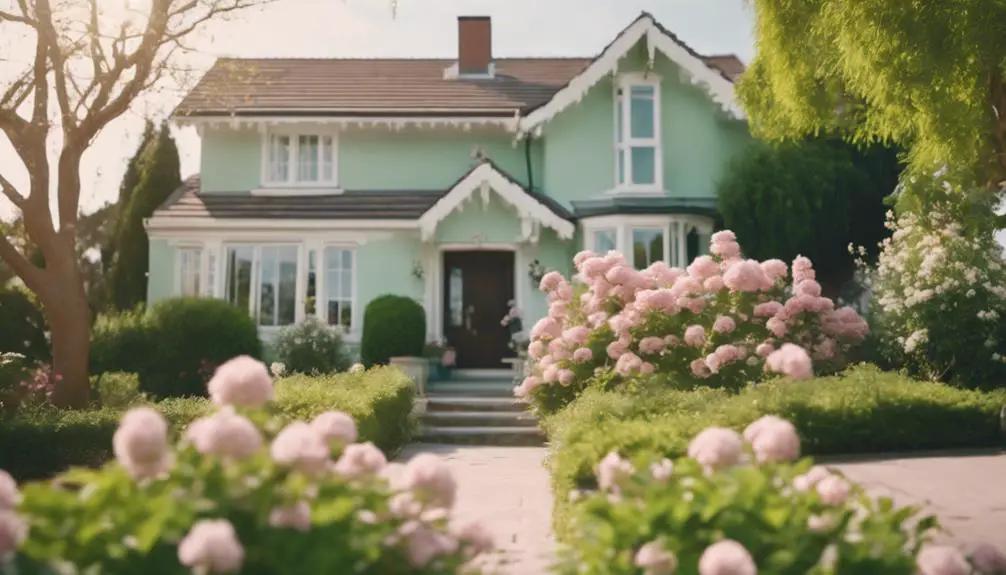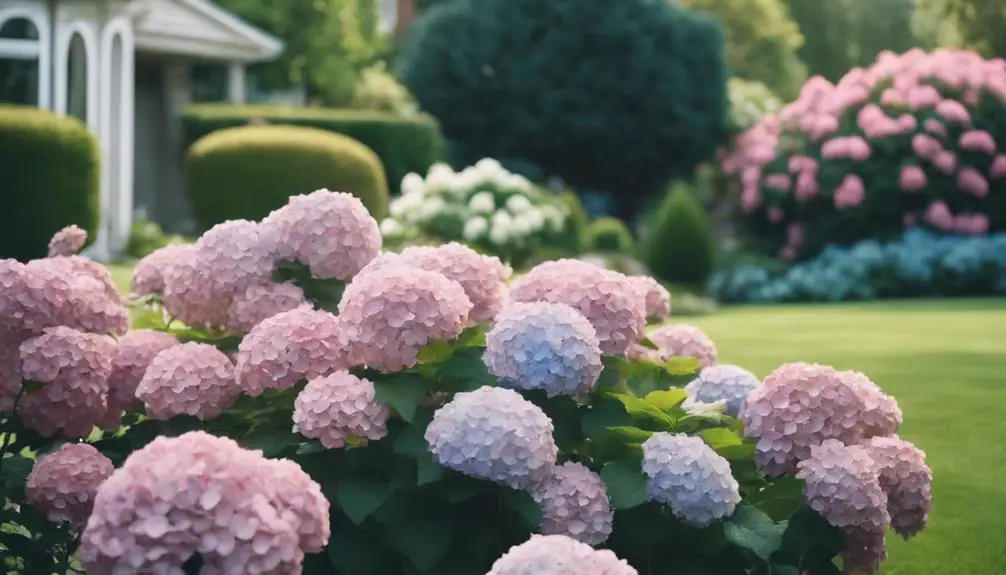When it comes to choosing the best bushes for in front of your house, you're likely pondering a mix of factors like climate, maintenance, and aesthetics. You might be drawn to drought-tolerant options like Texas Sage or Creosote Bush, perfect for desert landscapes with minimal watering and upkeep. But what if you want to add some vibrant color or year-round interest to your outdoor space? There are many more options to explore, each with its unique benefits and characteristics. As you weigh your choices, you'll want to ponder the specific needs and constraints of your property – and that's just the beginning.
Drought-Tolerant Shrubs for Dry Climates

In dry climates, yards can quickly turn into barren landscapes, but drought-tolerant shrubs can bring life back to your outdoor space.
These shrubs are perfectly adapted to thrive in desert landscapes, requiring minimal watering and maintenance. By incorporating them into your water-wise garden, you'll create a lush oasis that's both beautiful and sustainable.
When selecting drought-tolerant shrubs, look for species with deep roots, waxy leaves, or grayish foliage, which help retain moisture and reflect sunlight.
Some top picks include Texas Sage, Creosote Bush, and Mojave Yucca. These shrubs come in a range of sizes, shapes, and textures, allowing you to create a unique and visually appealing landscape.
Flowering Bushes for Colorful Accents
You can add vibrant spring blooms ahead with flowering bushes that produce showy flowers, like azaleas or rhododendrons, which burst with color as the weather warms up.
For a summer color pop, look for bushes that bloom in shades of pink, yellow, or orange, such as hydrangeas or butterfly bushes.
In the fall, fragrant foliage from bushes like burning bush or oakleaf hydrangea adds a sensory dimension to your outdoor space.
Vibrant Spring Blooms Ahead
Vibrant hues of spring awaken as flowering bushes burst forth with color, energizing your home's facade.
You can create a visually stunning display by incorporating bushes with vibrant spring blooms into your front yard landscape. Azalea bushes, for instance, produce showy clusters of pink, purple, or white flowers that burst forth in early spring, adding a pop of color to your exterior.
Weigela bushes, with their trumpet-shaped flowers in shades of pink, red, or white, are another great option. They bloom in late spring, providing a beautiful shift from spring to summer.
When selecting flowering bushes for your front yard, consider the USDA Hardiness Zone and the amount of sunlight your area receives. This will guarantee that your bushes thrive and provide the vibrant colors you're looking for.
Summer Color Pop
Beyond the vibrant hues of spring, summer flowering bushes take center stage, injecting a fresh wave of color into your landscape.
You're now in the midst of summer vibes, where hot hues dominate the scenery. To capitalize on this colorful momentum, incorporate bushes that thrive during this season.
Hydrangea bushes, for instance, burst with blue, pink, or white blooms, adding a pop of color to your front yard. Butterfly bushes, with their long, conical flowers, attract pollinators and create a stunning display of purple, pink, or yellow.
If you prefer a more subtle approach, consider Rose of Sharon or Bluebeard, which produce delicate, yet vibrant flowers that add a touch of elegance to your outdoor space.
Fragrant Fall Foliage
As fall's cooler temperatures set in, the landscape transforms, and flowering bushes with fragrant foliage take center stage, painting your front yard with warm, rich hues.
You'll be drawn to the sweet, heady aromas wafting from these bushes, inviting you to linger and savor the scents of the season.
To create a scented garden that's a true showstopper, incorporate bushes with fragrant fall foliage into your landscape design.
Shrubs like witch hazel, fragrant sumac, and sweetshrub offer Autumn aromas that are both enchanting and alluring.
Their vibrant yellow, orange, and red leaves create a kaleidoscope of color against the backdrop of a crisp blue sky.
When selecting flowering bushes for your front yard, consider varieties that offer a dual punch of color and fragrance.
Burning bush, for example, boasts brilliant red foliage and a sweet, spicy aroma that's irresistible.
Low-Maintenance Options for Busy Homeowners

You're looking for bushes that fit your fast-paced lifestyle, and that's where low-maintenance options come in.
Easy-care bushes like boxwood and holly require minimal pruning and upkeep, while drought-tolerant options like yucca and juniper can thrive with infrequent watering.
Easy Care Bushes
When selecting bushes for in front of your house, low-maintenance options are a must for busy homeowners who want to enjoy a beautiful landscape without sacrificing precious time.
Easy care bushes are perfect for petite landscaping, as they require minimal pruning, watering, and fertilizing. You'll appreciate the bush versatility, as they come in various shapes, sizes, and colors to fit your unique style.
Boxwood, for instance, is a popular choice for its compact growth habit and ability to be shaped into topiaries or hedges. It's also deer-resistant and can thrive in partial shade.
Another option is the Burning Bush, which boasts vibrant red foliage in the fall and can grow up to 10 feet tall. For a more compact option, the Dwarf Mondo Grass is an excellent choice, growing only 2-3 feet tall and requiring minimal maintenance.
These easy care bushes are perfect for homeowners who want a beautiful landscape without the hassle of constant upkeep. With their low-maintenance requirements, you can enjoy a stunning exterior without sacrificing your precious time.
Drought Tolerant Options
In front of your house, drought-tolerant bushes are a wise choice for busy homeowners who want to conserve water and reduce their maintenance routine.
These bushes are perfect for creating a desert landscaping look without sacrificing style or beauty. By choosing drought-tolerant options, you'll not only save water but also reduce the time spent on watering and pruning.
Some popular drought-tolerant bushes for Waterwise gardens include Texas Sage, Dwarf Mondo Grass, and Blue Star Juniper.
These bushes are designed to thrive in hot, dry conditions, making them ideal for areas with low rainfall. They're also low-maintenance, requiring minimal pruning and care.
When selecting drought-tolerant bushes, consider factors like soil type, sunlight, and mature size.
Choose bushes that fit your specific climate and landscape conditions. With the right selection, you can create a stunning, water-efficient landscape that requires minimal upkeep.
Evergreen Shrubs for Year-Round Interest
Evergreen shrubs provide a steadfast presence in front of your house, offering a year-round display of foliage, texture, and color that complements seasonal flowers and trees.
They add depth and visual appeal, even in winter when other plants are dormant. When selecting evergreen shrubs, consider their texture, which can range from soft and delicate to prickly and dense.
You can create contrast by pairing shrubs with varying textures, such as the soft needles of a dwarf spruce with the rough, scaly bark of a holly.
Look for shrubs that provide winter interest, like those with bright berries, golden foliage, or striking stem color.
Some popular options include boxwood, yew, and arborvitae. These shrubs can be pruned to maintain a formal shape or left to grow naturally, depending on your desired aesthetic.
Compact Bushes for Small Spaces

Beyond the front door, compact bushes can thrive in small spaces, seamlessly integrating into your home's façade while requiring minimal maintenance.
These bushes are perfect for urban dwellers or those with limited outdoor space. You can use them to create compact hedges or as petite accents to add visual interest to your exterior.
When choosing compact bushes, consider varieties that are naturally dwarf or compact, such as boxwood or holly. These bushes can be pruned to maintain a desired shape, adding a touch of sophistication to your home's exterior.
Alternatively, you can opt for compact, flowering bushes like lavender or rosemary, which will attract pollinators and add a pop of color to your space.
Compact bushes are also ideal for creating a low-maintenance landscape. They require less pruning and care compared to larger bushes, making them perfect for busy homeowners.
Plus, they can thrive in containers or directly in the ground, giving you flexibility in your design.
Deer-Resistant Bushes for Rural Areas
When choosing deer-resistant bushes for your rural home, you'll want to weigh deer-friendly plant alternatives that still provide visual interest.
Native bush species, such as those with thorny or bitter leaves, are often effective deterrents.
Deer-Friendly Plant Alternatives
Six to eight deer-resistant bushes strategically placed in front of your rural home can make a significant difference in protecting your landscaping from hungry visitors.
However, if you're looking to create a wildlife garden that attracts deer, you'll want to incorporate deer-friendly plant alternatives.
These plants won't only attract deer but also provide a natural food source, supporting local ecosystems.
When selecting deer-friendly plants, consider incorporating native species that are high in nutritional value, such as clover, alfalfa, or fruit-bearing shrubs like chokeberry or dogwood.
These plants will serve as deer attractants, drawing them to your garden and away from other areas of your landscaping.
By creating a wildlife garden, you'll not only attract deer but also support local biodiversity.
Just be sure to plant these deer-friendly species in areas where you don't mind deer visiting, as they can still cause damage to surrounding plants.
Native Bush Species
Incorporating native bush species into your rural landscaping can substantially enhance its natural beauty while providing a robust defense against deer.
By choosing native species, you're not only supporting local biodiversity but also creating a more resilient ecosystem. Native bushes have co-evolved with local wildlife, making them more resistant to deer grazing and other environmental stressors.
Native bushes also play a vital role in maintaining healthy soil and water cycles.
Many species have deep roots that act as soil stabilizers, preventing erosion and landslides. Others have adapted to thrive in poor soil conditions, requiring minimal maintenance and care.
By incorporating native bushes into your landscaping, you're creating a haven for local wildlife habitats. For example, shrubs like dogwood and hawthorn provide essential food and shelter for birds, while others like buttonbush and willow attract pollinators.
Deterrent Plant Combinations
Your rural landscape's first line of defense against deer can be a strategic combination of deterrent plant species.
By incorporating deer-resistant bushes, you'll create an intruder barrier that discourages unwanted visitors from venturing further. This crime deterrent approach is especially effective when combining plants with different growth habits, textures, and scents.
For a robust defense, consider pairing dense, thorny bushes like Barberry or Pyracantha with fragrant, flowering species like Lavender or Rosemary.
The resulting layering of textures and scents creates a formidable obstacle for deer. Additionally, incorporating plants with toxic or unpalatable foliage, such as Daffodil or Hyacinth, will further reinforce the barrier.
When selecting plants, prioritize those with natural deer-repellent properties, like hot peppers or garlic.
Hydrangea Bushes for Big Blooms

Behind your house's facade, hydrangea bushes unfold their majestic beauty, enchanting passersby with enormous, rounded clusters of flowers that bloom in shades of pink, blue, or white.
These showstoppers are perfect for creating a dramatic curb appeal.
To coax big blooms from your hydrangea bushes, you'll need to provide them with the right conditions. Hydrangea care involves planting them in well-draining soil with a pH between 6.0 and 6.5.
Make sure they receive partial shade to full sun, depending on the variety. Water them deeply once or twice a week, but avoid overwatering, which can lead to root rot.
Fertilize your hydrangeas in the spring with a balanced fertilizer, and prune them in late winter to encourage new growth.
With proper care, your hydrangea bushes will reward you with massive, vibrant blooms that'll be the envy of the neighborhood.
Boxwood Bushes for Classic Hedges
Classic hedges evoke a sense of timeless elegance, and boxwood bushes are the go-to choice for creating these structured borders.
You'll love how boxwood landscaping adds a touch of sophistication to your front yard. When used to create formal gardens, boxwood bushes provide a clean, crisp look that's hard to beat.
To get the most out of your boxwood bushes, plant them 12-18 inches apart to create a dense, uniform hedge.
You can also prune them regularly to maintain a specific shape or size. Boxwood bushes come in various species, including English, American, and Japanese, each with its own unique characteristics.
For a more dramatic effect, consider using topiary-style boxwood bushes, which can be shaped into spheres, cones, or other decorative forms.
When selecting boxwood bushes, look for compact, disease-resistant varieties that thrive in your local climate.
With proper care, boxwood bushes can live for decades, providing a beautiful, low-maintenance hedge that enhances your home's curb appeal.
Burning Bush for Fall Color

As you consider the best bushes for in front of your house, don't overlook the Burning Bush, a deciduous shrub that ignites the landscape with vibrant fall color.
With its rich history dating back to the 17th century, this shrub has been a staple in European gardens for centuries. Its claim to fame lies in its striking fall foliage, which transforms from green to a deep crimson, lasting up to six weeks.
The Burning Bush's fall foliage longevity is unparalleled, making it an ideal choice for homeowners seeking a dramatic autumn display.
Its dense, compact growth habit makes it suitable for borders, hedges, or as a standalone specimen. You'll appreciate its low-maintenance requirements, as it tolerates a range of soils and moisture levels.
Reaching maturity at around 10-15 feet tall, this shrub provides ample privacy and visual interest without overwhelming the surrounding landscape.
With its dazzling fall color and ease of care, the Burning Bush is an excellent addition to any front yard.
Privet Bushes for Fast Growth
Frequently, homeowners seeking to quickly establish a lush, verdant landscape turn to Privet bushes, renowned for their rapid growth rate.
These bushes can grow up to 3 feet per year, making them an ideal choice for those who want to rapidly transform their outdoor space. Privet bushes are also highly adaptable, thriving in a range of soil types and moisture levels.
To maintain their shape and promote healthy growth, regular Privet maintenance is essential. This involves frequent watering, fertilizing, and privet pruning to control their size and encourage dense foliage.
When pruning, focus on removing any dead or damaged branches to prevent the spread of disease. You can also shape your Privet bushes to create a formal hedge or topiary, adding visual interest to your landscape.
With proper care, Privet bushes can provide a lush, green backdrop for your outdoor space, perfect for hiding unsightly fences or creating a sense of privacy. By incorporating Privet bushes into your landscaping plan, you can quickly achieve a polished, sophisticated look that enhances your home's curb appeal.
Topiary Bushes for Unique Shapes

Topiary bushes, crafted into unique shapes, add an extra layer of sophistication to your outdoor space.
You can create a breathtaking visual display by choosing bushes that lend themselves well to topiary art. Look for species with small, dense foliage, such as boxwood, ivy, or yew.
These will hold their shape well and can be sculpted into intricate forms.
To achieve sculpted silhouettes, you'll need to prune your topiary bushes regularly. This involves clipping and shaping the foliage to maintain the desired form.
You can use topiary shears or clippers to achieve the desired shape. For more complex designs, consider using a topiary frame to guide your pruning.
When selecting a topiary bush, consider the shape you want to create and choose a species that fits your vision.
For example, a spiral topiary might require a bush with flexible branches, while a geometric shape might require a more rigid species.
With the right choice and regular pruning, you can create a stunning topiary display that adds a touch of elegance to your outdoor space.
Native Bushes for Local Charm
Native bushes, often overlooked in favor of exotic species, bring a unique charm to your outdoor space by evoking a sense of local character.
By choosing native bushes for your front yard, you're not only supporting local ecosystems but also creating a visually stunning display that resonates with the regional aesthetic.
For coastal gardens, consider native bushes like the beach rose or bayberry, which thrive in salty, windy conditions and add a touch of rugged beauty to your outdoor space.
In other regions, opt for bushes like the oakleaf hydrangea or the sweetbay magnolia, which flaunt striking foliage and elegant blooms that reflect the local flora.
When selecting native bushes, consider factors like soil type, climate, and sunlight exposure to guarantee they'll thrive in your specific environment.
By doing so, you'll create a cohesive, natural look that celebrates your region's unique character.
With native bushes, you can achieve a sense of authenticity and connection to your surroundings, making your outdoor space truly one-of-a-kind.
Frequently Asked Questions
How Often Should I Prune My Bushes to Maintain Their Shape?
You'll want to prune your bushes regularly to maintain their shape, ideally every 4-6 weeks during the growing season, and less frequently during dormant periods, following a pruning schedule that's tailored to your specific bush care tips and needs.
Can I Plant Bushes in Containers Instead of Directly in the Ground?
You can plant bushes in portable planters, giving you flexibility to adjust their placement, but guarantee the soil conditions match the bush's needs, and consider factors like drainage, aeration, and moisture retention to thrive.
Do I Need to Fertilize My Bushes Regularly for Optimal Growth?
You'll need to fertilize your bushes regularly to replenish soil nutrients, ensuring peak bush health and vibrant foliage. Aim for a balanced fertilizer, and apply it according to the product's instructions for the best results.
How Close to the House Should I Plant My Bushes for Best Results?
When planting, you'll want to guarantee adequate soil proximity for healthy root development, while maintaining sufficient foundation clearance to prevent water damage or structural issues; aim for a minimum of 12-18 inches between the bush and house foundation.
Can I Transplant Mature Bushes From One Location to Another Successfully?
When transplanting mature bushes, you'll face root disturbance and soil adaptation challenges. Dig carefully, preserving as much of the root ball as possible, and acclimate the plant to new soil conditions to guarantee successful relocation.
Conclusion
As you finalize your selection, remember to ponder factors like climate, space, and maintenance needs. By choosing the right bush for your front yard, you'll enhance your home's curb appeal and create a welcoming atmosphere. From drought-tolerant shrubs to flowering bushes, compact options, and unique topiary shapes, there's a perfect fit for your outdoor space. With your new bushes in place, enjoy the beauty and functionality they bring to your home's exterior.




